South America
Clouds far away above the sea, a cumulus rising like a volcano, then, coming closer, an island and a turquoise-coloured lagoon, surrounded by a maze of dark-green mangroves - that's the coast of South America, exactly of Venezuela with its Aura, a dream of discoverer Alexander von Humboldt two centuries ago, an own dream since boyhood...
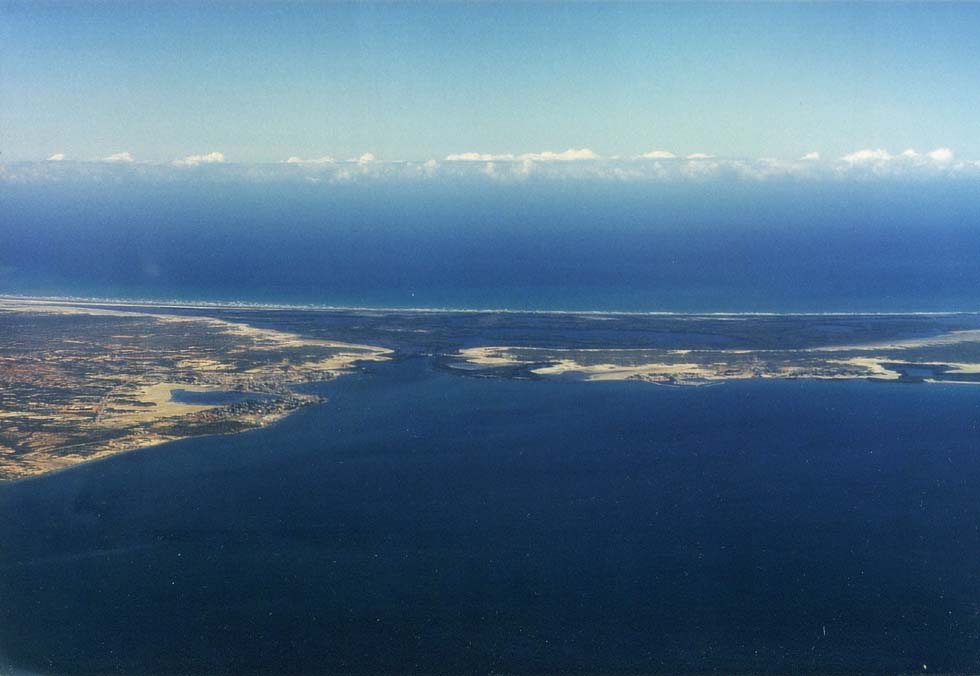
Isla Margarita at the coast of Venezuela (WS)
The North Coast
The passenger harbour of Venezuela was La Guaira, connected with the capital Caracas by a mountainous railway, replaced in the 1950s by a fantastic motorway, the "Panamericana". Still in the 80s La Guaira was served regularly by passenger-cargo vessels from Houston, USA, of Venezuelan Line. Later a natural disaster devastated the coast and only at the beginning of the 21st century the harbour was restored, now for cruise ships, but they scarcely did come. The lovely island Margarita became connected with Puerto La Cruz on the mainland in 1959 by Naviera Nueva Esparta with rebuilt river ferries. In 1969 Conferry took over. Ortel/ Foerster listed the new ferries "Santa Margarita" and "Maria Guevara" as well as the former "Stena Nordica" and other ferries of the Baltic Sea on the route Puerto de la Cruz - Punta de Piedras. Hi-speed services were started in the '70s with the passenger hydrofoils "Jet Caribe I" and II of Turismo Margarita. In 1996 the hi-speed Aquastrada-type monohull "Corsica Express I" was chartered by Conferry, replaced in 1997 for two years by the MDV monohull "Margarita Express" (originally the "Pegasus One", "Stena Pegasus", later "Autoexpress 4", "Speedrunner II", see chapter Aegean). ShipPax listed e.g. in 2005 the 86m Austal catamarans "Carmen Ernestina" of 1999 and "Lilia Concepcion" of 2002. Wikipedia listed e.g. in 2011 a fleet of 9 ships, including "HSC Lilia Concepcion", "HSC Carmen Ernestina" and since 2009 also the "HSC Tallink AutoExpress 2" of 1997. The timetable continued to mention also services by Naviarca and the Web mentioned the hi-speed "Gran Cacique Express". In 2009 the sensational 19,638-ton HSS catamaran "Stena Discovery" was acquired by Albamar of Venezuela for Margarita island services, baptized "HSS Discovery", followed by the "HSS Explorer".
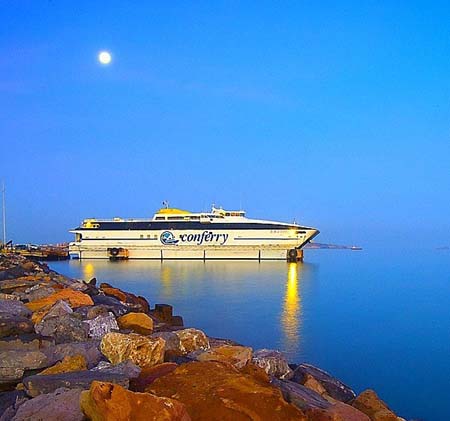 A Conferry hi-speed at Puerto de la Cruz (Edu, via Wikimedia)
A Conferry hi-speed at Puerto de la Cruz (Edu, via Wikimedia)
The formerly Dutch islands of Curacao and Aruba had been connected during decades with Punto Fijo and Coro in Venezuela by Ferrys del Caribe. In the 21st century they disappeared from the timetables.
The Guyanas
These countries had been divided up between England, the Netherlands (Suriname) and France in 1814. Hundred years later Bradshaw's timetable listed a route of the East Asiatic Co. from Copenhagen, Rotterdam and London to Demerara in British Guyana and Paramaribo, the capital of Suriname. Of course also other services existed during the colonial age. Towards the end of the 1970s, when Guyana and Suriname had become independent states, coastal services of the Georgetown Transport & Harbours Department and the Suriname Navigation Co. appeared still in the ABC Shipping Guide. Years ago passengers could travel by boat of the Guyana Transport & Harbours Department from the border of Venezuela over night to Georgetown, the capital of Guyana, then changing between buses, local ferries, boat of the NV Scheepvaart Maatschappij Suriname and bus to Paramaribo and once again by bus, ferry and bus to Cayenne, the capital of French Guyana. The Suriname service was suspended, but local car ferries in Guyana continued to operate.
Brazil
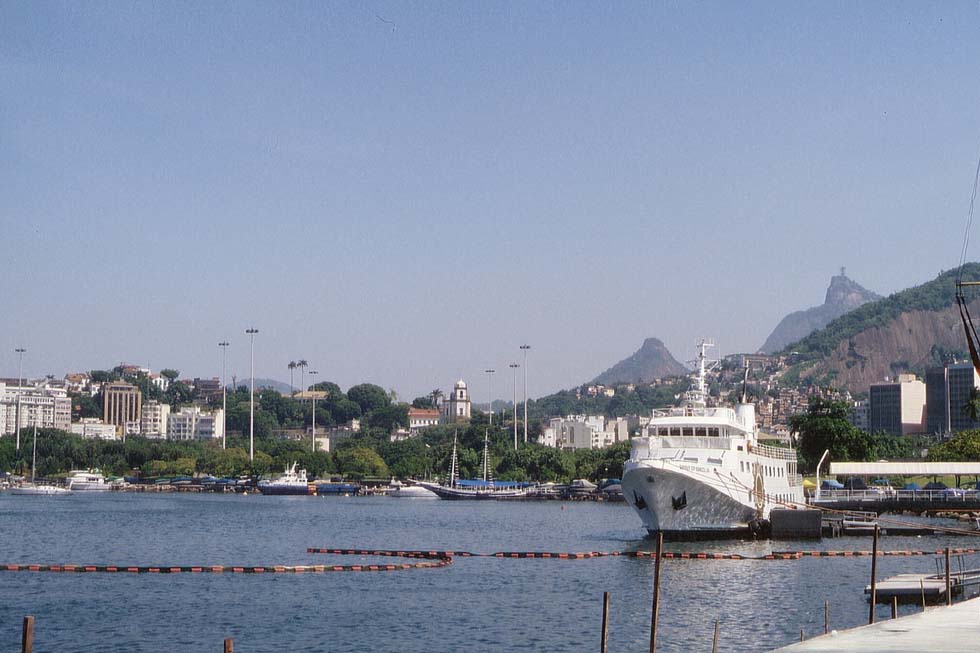
Rio de Janeiro and tourist boat "Spirit of Brazil", 2010 (WS)
Bradshaw's Timetable of 1914 showed a service by the Booth Steamship Co. from Liverpool to Ceara near Natal and to Manaus on the River Amazon - that city in the jungle which had become famous by its opera house where even Caruso appeared. Between Rio de Janeiro and Buenos Aires, state-owned Lloyd Brasileiro was from 1905 competed by Cruzero del Sul of Hamburg-Sued, a short-term attempt however.
From the 1960s, historian Curt Frick reported a service Buenos Aires - Rio de Janeiro - Belem - Manaus by the Companhia Nacional de Navegacao Costeira with the modern motor-ships "Anna Nery" and "Rosa de Fonseca" of 10,451 tons and smaller vessels, used also for cruises. The "Rosa de Fonseca" became the "Nippon Maru" of Mitsui OSK and the "Anna Nery" survived after many changes in ownership until 2009 as "Salamis Glory" in the Aegean. The ABC Shipping Guide of 1978 mentioned a Rio de Janeiro - Belem - Manaus route of Lloyd Brasileiro with the sad remark: "Service suspended". ENASA, later ENA, and other companies continued ferry services from Belem to Soure and to Macapa, a catamaran service Belem - Manaus and irregular connections by passenger-cargo vessels to Port Velho, to Pucalpa in Peru and also to Puerto Asis in Colombia. And even cruise ships, coming from Europe, are going upstream the Amazon.
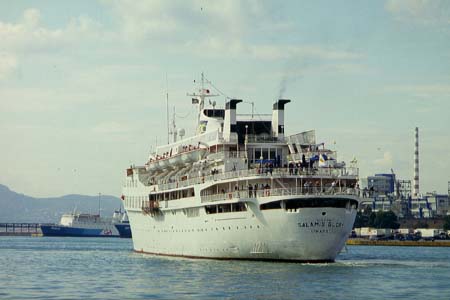 The former "Anna Nery", as "Salamis Glory" leaving Piraeus, 2007 (WS)
The former "Anna Nery", as "Salamis Glory" leaving Piraeus, 2007 (WS)
The Bahia de Todos os Santos is crossed by car ferries of COMAB, connecting the traditional city of Salvador with Itaparica. Best known of course were always the services between Rio de Janeiro and Niteroi. Though a 14 km long bridge has been built, the services were accelerated already in the 70s by hydrofoils and hovercraft. Now the catamarans or ferries of Transtur Aeorobarcos or of Barcas are crossing the Guanabara bay, the Pao de Acucar or Sugar Loaf in the background. There are tourist boats, too, and regular boats or small car ferries connecting various islands on the Brazilian coast.
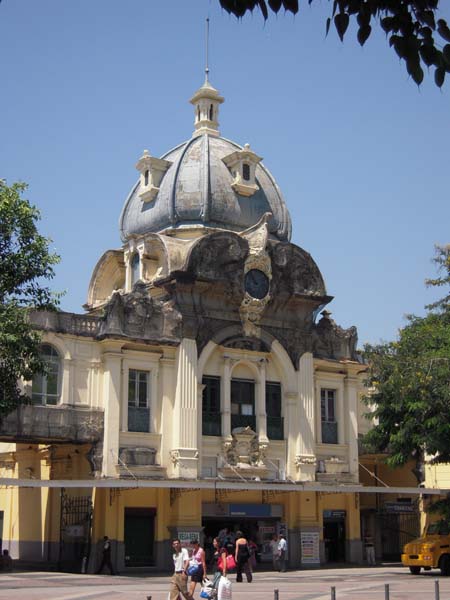
Rio de Janeiro, terminal (WS)
|
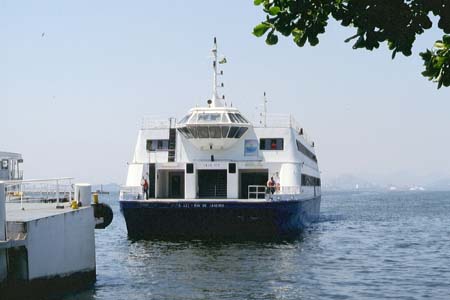
Niteroi service, Rio de Janeiro 2010 (WS)
|
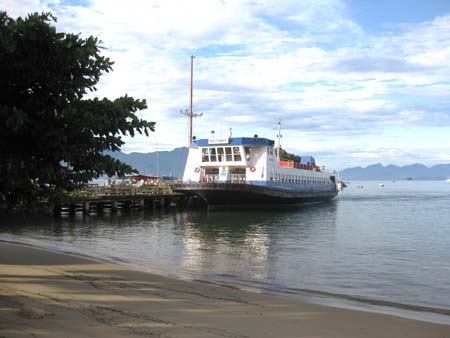
"Brizamar", Ilha Grande service, 2010 (Anton Soelch)
|
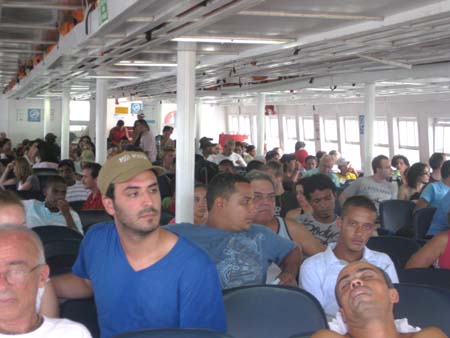
"Brizamar", 2010 (Daniela Soelch)
|
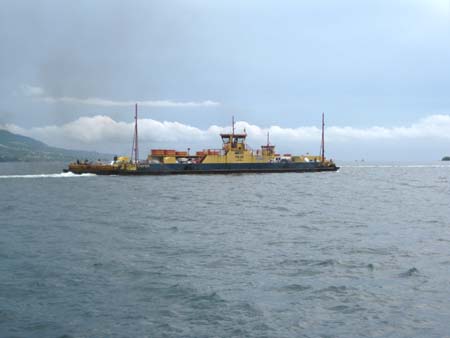 Ilha Bella service, 2010 (Anton Soelch)
Ilha Bella service, 2010 (Anton Soelch)
Argentina and Uruguay
The La Plata had been crossed by the ocean liners coming from Europe, calling at Montevideo, Uruguay, and then at the ocean terminal of Buenos Aires. In the 19th century the shipping firm A.C. de Freitas of Hamburg held a position in the trade between Argentina and Southern Brazil. In 1883 also the Hamburg-Sued entered that Rio Grande do Sul business.
Local services Montevideo - Buenos Aires were provided by the Uruguayan company Mihanovich. In 1913 the Hamburg-Sued entered that business with the Cia. Argentina de Nav. . Later the shipping services from Buenos Aires to Uruguay were provided by the Flota Fluvial del Estado. Still in the beginning of the 1960s no direct car ferry services existed.
This market was discovered by Ferrylineas Argentinas. Initially known as Makalle SA or Navegacion Atlantida SA, they introduced in 1967 the "Atlantic", a rebuilt landing boat of the U.S. Navy, on the first car ferry service Argentina - Uruguay. Also the Flota Fluvial had entered the ferry business, but stopped its services Buenos Aires - Colonia in 1979. Ferrylineas Argentinas added in 1975 to its Colonia route a direct night service Buenos Aires - Montevideo with the "General Jose Artigas", the former "Prinsessan Christina" of Sweden, in 1977 however sold to Venezuela.
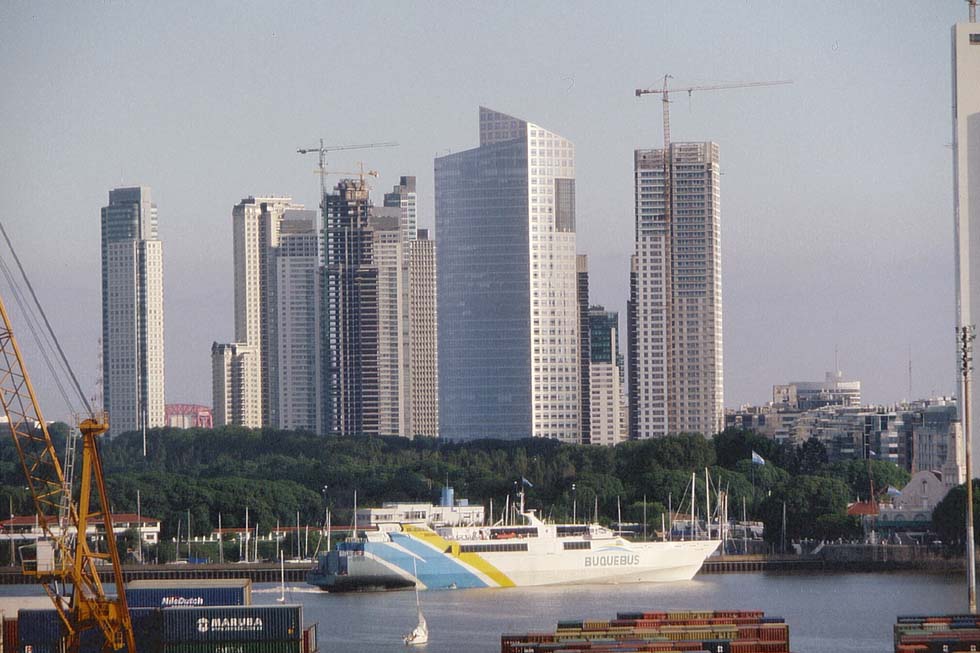
A Buquebus hi-speed from Uruguay arriving at Buenos Aires, 2010 (WS)
Towards the end of the 1970s the ABC Shipping Guide listed already a hydrofoil service Buenos Aires - Colonia by Alimar. Later 'aliscafo' hydrofoils of Puente Fluvial were reported. Famous high-speed provider became Buquebus Los Cipreses SA of Uruguay, founded in 1980 as Rios Ar, then renamed and finally known as Buquebus. Initially they started conventional ferry services. Their change to hi-speed operations was described by Ortel/ Foerster: Impressed by the "Hoverspeed Great Britain", the enterprise commissioned the similar "Patricia Olivia", delivered by InCat in 1992, followed by the "Juan L.", in 1995 by the "Juan Patricio", built for a speed of 55 knots, then by monohulls and in 1997 by the smaller catamaran "Luciano Federico", capable of running at 57 knots. It covered the 116 nm Buenos Aires - Montevideo in 2 to 2.30 hours, supported by the river current. In late 1997 Buquebus introduced the 7,895-ton monohull "Silvia Ana L" of the Spanish Alhambra type, 125 m long, laid out for 1,250 passengers and 250 cars, operating Buenos Aires - Colonia, during European summer months repositioned to Larvik Line/ Color Line of Norway. The "Albayzin", used by Buquebus Espana, became listed by ShipPax for Ferrylineas Argentinas. In early 2010 the white/ blue boat was to be seen at the Buquebus terminal in Buenos Aires. A Ferrylineas Argentinas ad 'ahora es seacat' praised the "Seacat Colonia" running from Buenos Aires to Colonia in 50 minutes, competing with Buquebus and Colonia Express. La Plata crossings from Tigre were offered by La Cacciola.
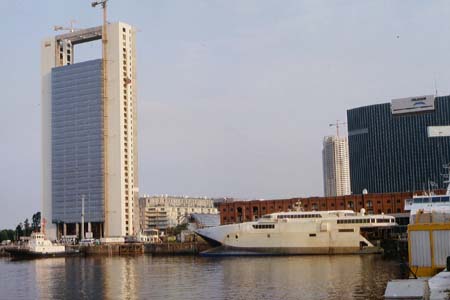
"Atlantic III" of Buquebus, Buenos Aires 2010 (WS)
|
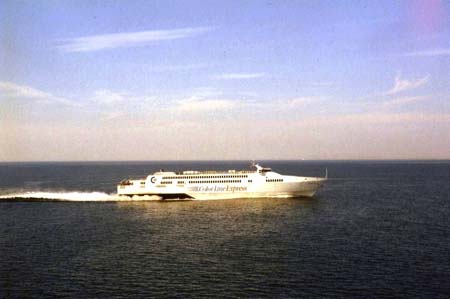
"Silvia Ana L" on the way to Norway, 1997 (Mario Fuchs, via Wikimedia)
|
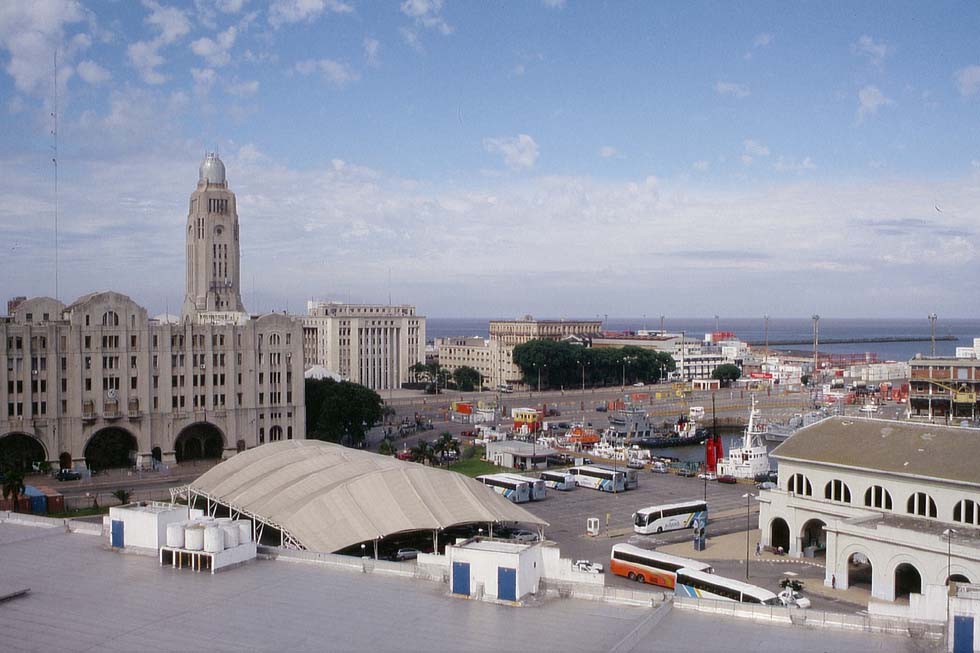
Montevideo, Buquebus terminal, 2010 (WS)
Patagonia to Fireland
Patagonia, the southern region of Argentina, was served during decades until WWI e.g. by steamers of the Linea Nacional del Sud created by the Hamburg-Sued, Antonia Delfino and Hapag under Argentinean flag. The southernmost harbour of Argentina is Ushuaia on the island Tierra del Fuego or Fireland. That remote port, situated on the Beagle Channel in the utmost south, was linked with Buenos Aires still towards the end of the 20th century by Transportes Navales. Around the millennium that once-monthly service disappeared. Then Ushuaia could be reached only by bus from Rivadavia and Rio Gallegos, crossing the Strait of Magellan between Punta Delgada and Punta Espora aboard a Chilean ferry. Ushuaia is now a port for Antarctic cruises.
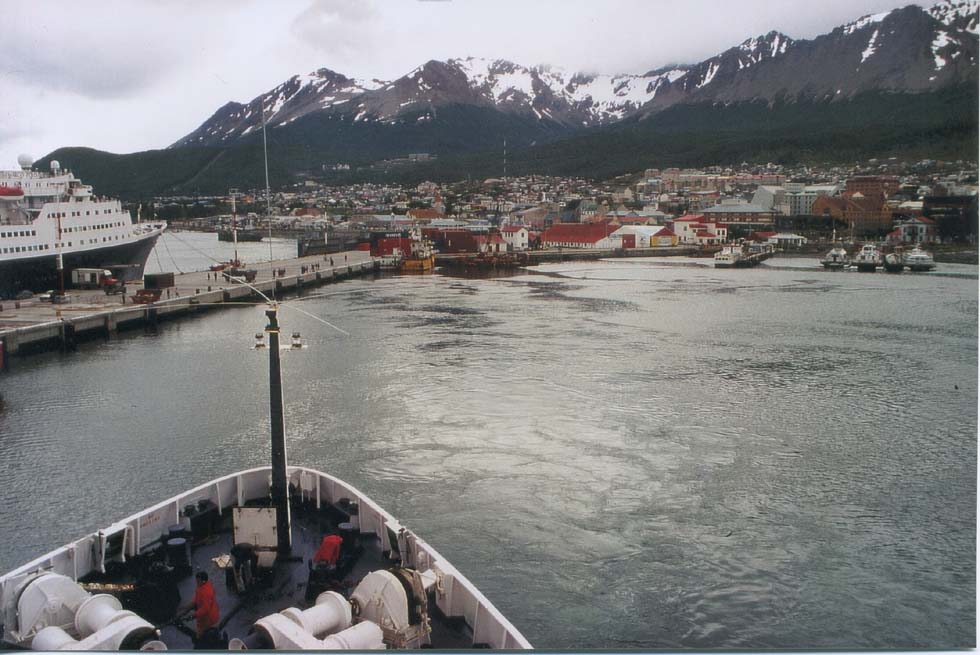
Ushuaia, seen from the "World Discoverer", Dec. 1997 (Margit Orthgiess)
Falklands
Still more remote routes connected the British-owned Falkland Islands. Around 1880 even a German company, the DDG Kosmos, got a mail contract for the Falklands, under condition that they provide also a local inter-island service. For that purpose they used the tiny "Malvinas". At the end of the 1970s there was still a passenger-cargo service Buenos Aires - Ushuaia - Falklands with the "Bahia Buen Sucesco" of the Armada Argentina. In 1982 the Argentinean military dictators started the Falklands War, the last colonial adventure for England. Then Cook Overseas Timetable listed Stanley Services only from Chile, between Punta Arenas and the Falklands, with the remark: "Journey 2-3 days. Irregular service, approximately every 6-8 weeks. Ship carries a maximum of 4 passengers". Then not any information was available.
Chile to Fireland
Puerto Montt, the southern railway terminus of Chile, was the traditional port of departure for the utmost south of Chile. Nearby Isla de Chiloe was and is a destination of local ferries and even a bridge had come into consideration. The remote south was connected still after WWII by a shipping route from Puerto Montt to Punta Arenas by state-owned Empremar, in the 70s with the "Navarino", later also by Cochifas Thos. Cook Overseas Timetable listed in the early 80s the Puerto Montt - Punta Arenas route served by Cochifas, Empremar and El Navarino. In 1979 Navimag started services Puerto Montt - Punta Arenas (according to Wikipedia). The South American Handbook reported problems of Empremar Sur in 1991. In the years to follow, Cook's continued to list Empremar, but only with cargo/passenger and cruise services to Chacabuco, Navimag with services Puerto Montt - Puerto Natales and Transmarchilay with routes from Chacabuco. ShipPax mentioned in the 21st century Navimag with ro-pax ferries on the Puerto Montt - Chacabuco and Puerto Natales routes. Then a hi-speed service of Aysen Express Puerto Montt - Puerto Chacabuco appeared in the timetables. The Puerto Montt - Punta Arenas service had disappeared already before and in the new century Puerto Montt is no longer a terminal for the traditional passenger trains from Santiago. At Puerto Natales the tourists may board a boat of Navigacion a los Glaciales for a trip to the glaciers of the Fiordo Ultima Esperanza. Punta Arenas can be reached only by bus from Puerto Natales.
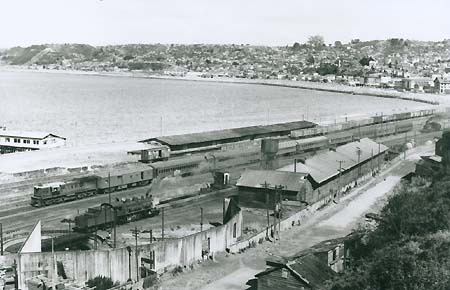
Puerto Montt, the express for Santiago waiting for departure, 1979 (Marc Dahlstrom)
|
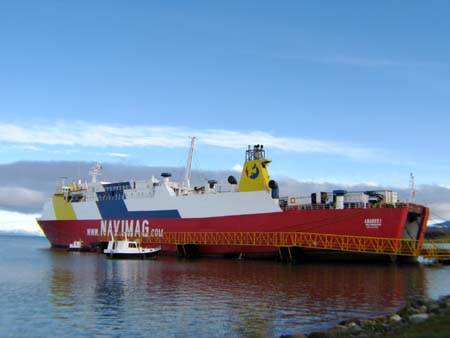
"Amadeo I" of Navimag at Puerto Natales, 2009 (Serge Ouachee, via Wikimedia)
|
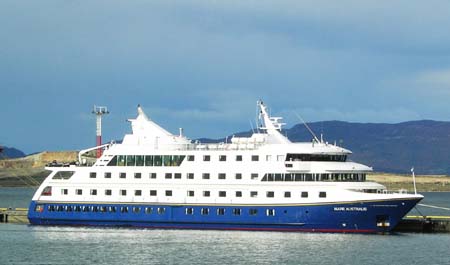
"Mare Australis" of Crucero Australis, cruising from Punta Arenas, at Ushuaia 2006 (Remi Jouan, via Wikimedia)
|

"Barcaza Melinka" of Transbordadora Austral Broom at Porvenir, 2006 (via Wikimedia)
|
Fireland was divided up between Chile and Argentina in 1881. Now, coastal shipping is provided with car ferries, crossing the Strait of Magellan on the way to Fireland. Transbordadora Broom, starting in 1968, has taken over the services Punta Delgada - Punta Espero from Ferry Patagonia and Tres Puentes (near Punta Arenas) - Porvenir from Empremar and Naviera del Estado. The Porvenir service was opened in 1984 with the landing-craft "Melinka". After various companies with sporadic services have disappeared from the utmost south, Transbordadora Austral Broom became listed also with a passenger service connecting Puerto Williams on the Isla Navarina, described as the most southerly place in the world with a permanent population.
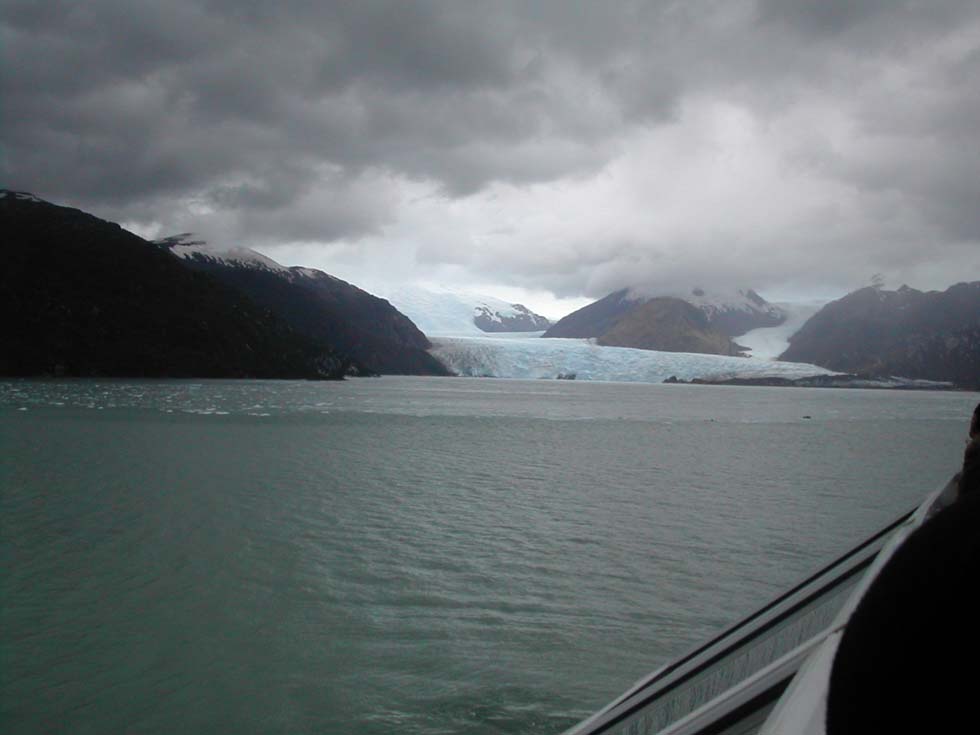
The South of Chile (Dr. Henning Saul)
South American Pacific Coast
It was by the way of Panama and the Pacific that the 'conquistadores' had reached the empire of the Inka and destroyed this culture... During the early steam age, the Pacific Coast ports were connected by ocean liners taking the other way via Cape Horn (see the main chapter South Atlantic). Valparaiso was always the destination - that romantic old city, spread over hills surrounding the sea, praised by Pablo Neruda: "I love Valparaiso..., bride of the Ocean."
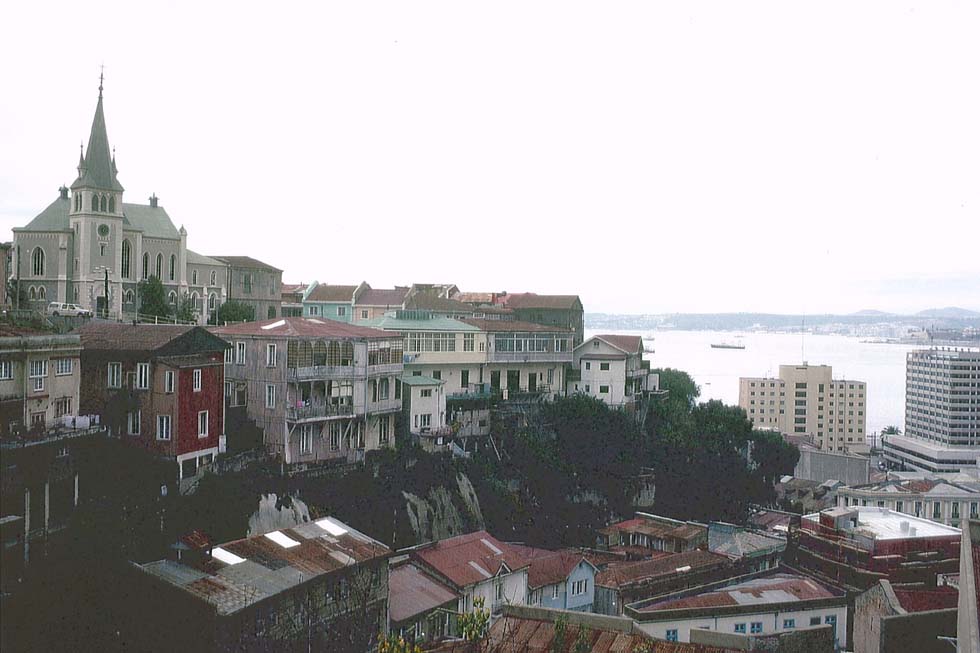
Valparaiso, the main harbour of Chile (WS)
William Wheelright founded in 1838 in London the Pacific Steam Navigation Co. (PSNC). Awarded with a mail contract for services along the Pacific Coast, his PSNC started in 1840 a service from Chile to Callao, the port of Lima in Peru, with the wooden steamers "Chile" and "Peru" of c.700 tons each, sent out via Cape Horn. In 1846 the service was extended to Panama with the iron paddler "Ecuador", followed by the first compound-engined steamer "Valparaiso" of 1,050 tons and the "Pacific" quartette, all the ships paddle-wheelers (information by Charles Robert Vernon Gibbs). Thus the connection with the 'Panama Overland' route and from 1855 with the Panama Rail Road was achieved. Later the Compagnie Generale Transatlantique targeted Panama traffic, too. After negotiations with the competitors they abandoned the idea of a Panama - San Francisco route, but a service Panama - Valparaiso was tried in 1872 with the "Ville de Brest" (1872/ 2,676gt) and sisters "Ville de Saint-Nazaire" and "Ville de Bordeaux". On their transfer they took the way through the Magellan Strait, while at that time generally the Cape Horn route was chosen. Also White Star and Ryde Line entered the Pacific Coast market, but all these initiatives proved overdone.
The Cia. Sud-Americana de Vapores (CSAV) of Chile was founded in 1872 and got cabotage rights. Among foreign companies, the PSNC, later also the tightly connected RMSP, as well as Lamport & Holt, Greenock S.S. Co., DDG Kosmos, the Hamburg-Pacific-Dampfschiffs-Linie, Cia. Peruana de Vapores and other lines served Valparaiso or other ports.
Wheelright had initiated Chile's first railway, linking the harbour Caldera with Capiapo, and he has envisioned a rail link between the main harbour Valparaiso and Argentina. Later that Ferro-Carril Trasandino was completed in 1910. It shortened traveling time between Europe and Chile by avoiding the passage through the Strait of Magellan or the ride across the Andes.
With opening of the Panama Canal in 1914, steamers from Europe could take that new route. In 1926 Hapag and NDL, which served the west coast, started a branch line Panama - Guayaquil. For many decades Grace Line provided the more important connection between New York and the South American west coast ports via the Panama Canal. In the late 1970s Prudential Lines of San Francisco was the only provider of regular services. Traditional CSAV continued freight traffic, but abandoned passenger service.
Nowadays, passenger shipping along the coast of South America has disappeared almost completely. In Ecuador, a local ferry connects the notorious harbour Guayaquil with Duran, where in the past the steam train to the capital Quito had its departure. Tramsfa operated a coastal shipping line from Guayaquil to Esmeraldas in the north, as well as passenger-cargo services to the Galapagos Islands, belonging to Ecuador. Then not any information was available. Foreign tourists may choose the plane and Galapagos inter-island cruises from Baltra, offered by various companies - on the track of Charles Darwin, who developed here the theory of evolution.
Bolivia is the only country which has lost access to the ocean in the 19th century with the War of the Pacific. In 1884 the province of Antofagasta was annexed by Chile, but as a sort of compensation the harbour of Antofagasta, later also Arica, got a rail connection with Bolivia. Another access to Bolivia was given by rail from the harbour Mollendo, crossing the Lake Titicaca in an altitude of c. 4,000 metres by steamer. In 1883 the first lake steamer "Yavari" was assembled at Puno and in 1929 the bigger cabin steamer "Ollanta" was introduced. They connected Puno with Guaqui, where in 1905 a rail connection to Bolivia's capital La Paz had been established. Still at the end of the 1970s the "Ollanta" and the "Inca" of Peruvian railways Enafer served the route Puno - Guaqui. Hovermarine Titicaca Transport and a hydrofoil of Crillon Tours opened services from Puno with bus connection to La Paz. The "Ollanta" terminated regular services already in 1981 and the railway Guaqui - La Paz was abandoned. During a journey in 1996 the only way was to take a bus from Puno and change at Copacabana to one of two little connecting buses, which crossed the Estrecho de Tiquina aboard open pontoons, while the passengers had to take a tiny motor-boat.
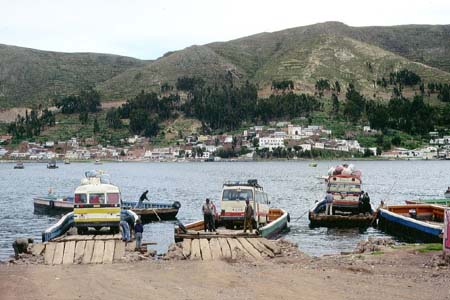
Estrecho de Tiquina, Bolivia, 1996 (WS)
|
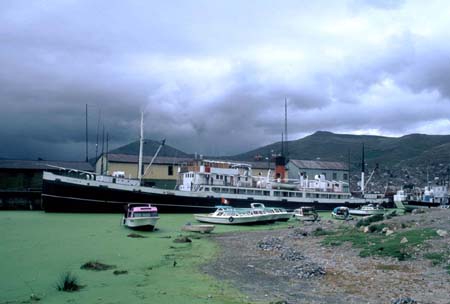
Puno, Lake Titicaca and the "Ollanta", 1996 (WS)
|
|